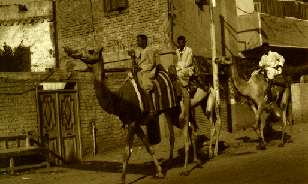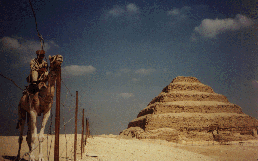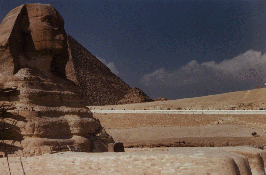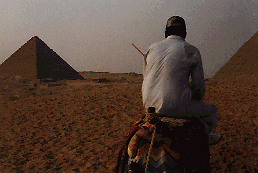 Monday, October 30
Monday, October 30A Trip to the Pyramids
After another early morning Egyptian breakfast of breads, cheese, and caffeine, we hired a taxi for the entire morning to take us to the pyramids of Saqqara and Giza. Our driver, Ibrahim, spoke some English, but kept to himself most of the time, except to point out the occasional landmark ("Israeli Embassy - very nice....")
We first went to Saqqara, about 15 miles south of Cairo at the edge of the Libyan Sahara desert. The drive took us through numerous fabric and vegetable markets, which I observed while Susanne tried to catch up on lost sleep. As we approached Saqqara, I noticed the first signs of the impending desert: caravans of camels marched in and out of the bazaars, trekking along the road against a backdrop of never-ending palm groves. Behind the trees, though, you couldn't see much, but soon it became clear that this nothingness was really the empty, sandy shore of the Sahara itself.
 As we reached the road to the desert, Saqqara's most famous site, the Zoser Step Pyramid, loomed in the distance. Zoser is the oldest standing pyramid on earth, built around 2700 BCE. The pyramid complex was surrounded by the remains of fallen temples, whose broken columns are reportedly the oldest know. The pyramid itself, with its aging steps holding up rather well despite their age, dominated the entire site. The basic dimensions were somewhat reminiscent of the Great Temple of Kulkulkan at Chichen Itza in the Yucatan of Mexico.
As we reached the road to the desert, Saqqara's most famous site, the Zoser Step Pyramid, loomed in the distance. Zoser is the oldest standing pyramid on earth, built around 2700 BCE. The pyramid complex was surrounded by the remains of fallen temples, whose broken columns are reportedly the oldest know. The pyramid itself, with its aging steps holding up rather well despite their age, dominated the entire site. The basic dimensions were somewhat reminiscent of the Great Temple of Kulkulkan at Chichen Itza in the Yucatan of Mexico.
About seven kilometers south of the pyramid you could see the smaller, younger pyramids of South Saqqara, which were too far out of the way for us to visit. So after our taking of too many pictures, including some shots of a policeman on a camel (for small baksheesh, of course), we got back in our taxi and headed north to Giza.

The 10km drive to Giza took about an hour, as we were stuck behind numerous lorries which kicked up enormous amounts of limestone dust and debris, turning the taxi, the surrounding trees, and passing camels to a strange shade of yellowish white. We drove through the urban neighborhoods of Giza (east Cairo), which is packed with row after row of apartments, tenements, and tourist traps. Once at the entrance of the pyramids, though, we could see in all of their glory the three main pyramids of Cheops, Chefren and Mycerinus, guarded by the infamous Sphinx. The Sphinx itself was smaller than I imagined - only 22m high - but was impressive and inspiring nonetheless. Three gay men from the states took our pictures for us there and joked about how the photos would definitely end up as "this year's Christmas cards," my Jewish heritage not withstanding.
 We hiked the steep hill between the Sphinx and Cheops and hooked to the right, walking along the foot of the pyramid. There were many well-dressed Egyptian teenagers hanging out with portable radios, singing along as they went. When we reached the entrance to Cheops, the guards shook their heads and said "need extra ticket," a ticket which we didn't have, and the ticket booth was a good kilometer away back at the entrance of the site. Since we had to go back down hill anyway, we decided to go back and take a rest stop at the Egypt House cafe, which sits about 100 yards in front of the Sphinx. We stayed there for a good two hours, downing cokes, bottled water, and overcooked kufta kabob sandwiches. A stray dog kept Susanne occupied as I worried half seriously about the potential illnesses it might pass on to us.
We hiked the steep hill between the Sphinx and Cheops and hooked to the right, walking along the foot of the pyramid. There were many well-dressed Egyptian teenagers hanging out with portable radios, singing along as they went. When we reached the entrance to Cheops, the guards shook their heads and said "need extra ticket," a ticket which we didn't have, and the ticket booth was a good kilometer away back at the entrance of the site. Since we had to go back down hill anyway, we decided to go back and take a rest stop at the Egypt House cafe, which sits about 100 yards in front of the Sphinx. We stayed there for a good two hours, downing cokes, bottled water, and overcooked kufta kabob sandwiches. A stray dog kept Susanne occupied as I worried half seriously about the potential illnesses it might pass on to us.
 Around 3pm we started to hike into the desert south of the pyramids complex and were immediately pummeled by groups of camel guides jockeying for our patronage. As annoying and rude as most of them were, we concluded that a trip to the pyramids without the obligatory camel ride would gnaw at our guts for years to come. Susanne and I mounted a camel, which growled and farted incessantly. I never realized how high off the ground camels' humps were until I started to fear for my safety as we swayed back and forth to the camel's gait. Soon enough, though, we were surrounded by the Eastern Sahara, though in reality the strips of souvenir shops were less than a mile away beyond the high sand dunes.
Around 3pm we started to hike into the desert south of the pyramids complex and were immediately pummeled by groups of camel guides jockeying for our patronage. As annoying and rude as most of them were, we concluded that a trip to the pyramids without the obligatory camel ride would gnaw at our guts for years to come. Susanne and I mounted a camel, which growled and farted incessantly. I never realized how high off the ground camels' humps were until I started to fear for my safety as we swayed back and forth to the camel's gait. Soon enough, though, we were surrounded by the Eastern Sahara, though in reality the strips of souvenir shops were less than a mile away beyond the high sand dunes.
Sore from the experience, we limped back to the cafe after parting from our guide and our flatulating dromedary friend. The sun was beginning to set, so the crowds at the foot of the Sphinx increased dramatically as they all attempted to get that postcard-perfect shot to show off to their friends back in Pittsburgh, Osaka, Frankfurt, or from wherever else they hailed.
The cab ride back to Midan Ramsis and our hotel was a continuos horn-blast through traffic. After killing some time in the room, we went upstairs to the Fontana Cafe. I drank some Stella while Susanne enjoyed a 7-Up while we both munched on peanuts and this wonderful meat and rice dish, surrounded by a small crowd of subdued, sophisticated Cairenes. The dark cafe was an incredible contrast to the din and activity in Midan Ramsis below us, where cars twisted and turned in every directions like lemmings on amphetamines. Another night in the life of el-Qahira, Misr.
Take me to the next entry.
Take me back to the journal index.
Get me outta here and back to Andy's Waste of Bandwidth.



EdWeb: Exploring Technology and School Reform, by Andy Carvin. All rights reserved.
time management gamesaction gamespc game downloadsdownloadable gamesadventure gamesmanagement gamesbrain teaser gamesplatform gamesword gamesshooter games As we reached the road to the desert, Saqqara's most famous site, the Zoser Step Pyramid, loomed in the distance. Zoser is the oldest standing pyramid on earth, built around 2700 BCE. The pyramid complex was surrounded by the remains of fallen temples, whose broken columns are reportedly the oldest know. The pyramid itself, with its aging steps holding up rather well despite their age, dominated the entire site. The basic dimensions were somewhat reminiscent of the Great Temple of Kulkulkan at Chichen Itza in the Yucatan of Mexico.
As we reached the road to the desert, Saqqara's most famous site, the Zoser Step Pyramid, loomed in the distance. Zoser is the oldest standing pyramid on earth, built around 2700 BCE. The pyramid complex was surrounded by the remains of fallen temples, whose broken columns are reportedly the oldest know. The pyramid itself, with its aging steps holding up rather well despite their age, dominated the entire site. The basic dimensions were somewhat reminiscent of the Great Temple of Kulkulkan at Chichen Itza in the Yucatan of Mexico.  Monday, October 30
Monday, October 30
 We hiked the steep hill between the Sphinx and Cheops and hooked to the right, walking along the foot of the pyramid. There were many well-dressed Egyptian teenagers hanging out with portable radios, singing along as they went. When we reached the entrance to Cheops, the guards shook their heads and said "need extra ticket," a ticket which we didn't have, and the ticket booth was a good kilometer away back at the entrance of the site. Since we had to go back down hill anyway, we decided to go back and take a rest stop at the Egypt House cafe, which sits about 100 yards in front of the Sphinx. We stayed there for a good two hours, downing cokes, bottled water, and overcooked kufta kabob sandwiches. A stray dog kept Susanne occupied as I worried half seriously about the potential illnesses it might pass on to us.
We hiked the steep hill between the Sphinx and Cheops and hooked to the right, walking along the foot of the pyramid. There were many well-dressed Egyptian teenagers hanging out with portable radios, singing along as they went. When we reached the entrance to Cheops, the guards shook their heads and said "need extra ticket," a ticket which we didn't have, and the ticket booth was a good kilometer away back at the entrance of the site. Since we had to go back down hill anyway, we decided to go back and take a rest stop at the Egypt House cafe, which sits about 100 yards in front of the Sphinx. We stayed there for a good two hours, downing cokes, bottled water, and overcooked kufta kabob sandwiches. A stray dog kept Susanne occupied as I worried half seriously about the potential illnesses it might pass on to us.  Around 3pm we started to hike into the desert south of the pyramids complex and were immediately pummeled by groups of camel guides jockeying for our patronage. As annoying and rude as most of them were, we concluded that a trip to the pyramids without the obligatory camel ride would gnaw at our guts for years to come. Susanne and I mounted a camel, which growled and farted incessantly. I never realized how high off the ground camels' humps were until I started to fear for my safety as we swayed back and forth to the camel's gait. Soon enough, though, we were surrounded by the Eastern Sahara, though in reality the strips of souvenir shops were less than a mile away beyond the high sand dunes.
Around 3pm we started to hike into the desert south of the pyramids complex and were immediately pummeled by groups of camel guides jockeying for our patronage. As annoying and rude as most of them were, we concluded that a trip to the pyramids without the obligatory camel ride would gnaw at our guts for years to come. Susanne and I mounted a camel, which growled and farted incessantly. I never realized how high off the ground camels' humps were until I started to fear for my safety as we swayed back and forth to the camel's gait. Soon enough, though, we were surrounded by the Eastern Sahara, though in reality the strips of souvenir shops were less than a mile away beyond the high sand dunes. 

